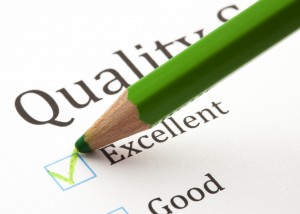 “Quality” may be one of the more over-used and least-thought-about words in our business vernacular. We’ve gone through cycles where we used different terms to characterize our attempts to “do” quality better. Remember Total Quality Management? How about the focus on ISO 9000? And more recently, “Six Sigma,” “Lean,” and “Agile” have emerged as concepts to address shortfalls in performance and the inability to consistently deliver high-quality capability. Through this evolution, we’ve continued to pursue methods to reduce mistakes and track process enhancements to ensure we’ve fixed the problem. We’ve figured out we need to quantify and measure what we’re doing so we can confirm the changes we’ve made to address problems, have actually worked.
“Quality” may be one of the more over-used and least-thought-about words in our business vernacular. We’ve gone through cycles where we used different terms to characterize our attempts to “do” quality better. Remember Total Quality Management? How about the focus on ISO 9000? And more recently, “Six Sigma,” “Lean,” and “Agile” have emerged as concepts to address shortfalls in performance and the inability to consistently deliver high-quality capability. Through this evolution, we’ve continued to pursue methods to reduce mistakes and track process enhancements to ensure we’ve fixed the problem. We’ve figured out we need to quantify and measure what we’re doing so we can confirm the changes we’ve made to address problems, have actually worked.
In the federal space, there is an increased emphasis on writing more Performance Work Statements (PWS) and Quality Assurance Surveillance Plans (QASP) into contracts as organizations attempt to shift focus from “how” to “what.” Instead of a Statement of Work that stipulates how a contractor will perform the required task, a PWS defines the product or services to be delivered and gives the contractor latitude to find a better way to provide the product or service. The QASP documents the government customer’s approach to measuring key aspects of contractor performance. This sounds great in theory and has worked well where performance can truly be measured.
But how do you measure performance in a service environment? There are metrics that can be tracked, but do those metrics directly relate to the overall quality of the service? When you go to a restaurant, how do you assess the quality of your dining experience? Was the food tasty? Was the meat cooked to the right temperature? Was the service prompt and courteous? Did the waitress keep your water glass full? How expensive was the meal? How long did you have to wait to be seated? Some of these factors can be measured directly. Some are yes/no questions. Some are measurable on a sliding scale. Now let’s double those criteria. How did your dinner partner rate those same service features? These all factor into your assessment of the dinner and your ultimate decision to return to that restaurant again.
These are just some performance criteria that factor into a decision on which restaurant to choose for dinner. Now let’s take it one step further. How do you measure performance when those services are professional services an agency needs to support its day-to-day operations? This quickly gets more complicated than assessing a restaurant’s performance in providing a dining experience.
What are the important aspects of performance you want to measure and are there ways to measure them? Stay tuned for Part II of this blog, as I’ll use a simple example to frame the challenge and talk about two key factors, namely communication and relationship building, which contribute to achieving quality in a service environment.



